With regular trains from Paris to Bordeaux, you can be easily be sipping Grand Cru Classé in the blink of an eye. Paris to Bordeaux travel is a cinch thanks to the high speed trains in France finally linking the two cities as of 2017. The TGV Paris Bordeaux route reduced the formerly 3.5 hour journey to a fast 2 hours and 4 minutes. It’s such fast trip between Paris Montparnasse and Gare de Bordeaux-Saint-Jean that you barely have time to settle in and queue up in the bar car for a snack, in the best way possible.
While Bordeaux does have the Bordeaux–Mérignac Airport, it’s often less expensive and there are far more flight options when you arrive to France in Paris. Living in Bordeaux, we ourselves often fly to international destinations off the European continent from Paris. The 2-hour fast train to Paris and the fares on low-cost OUIGO make flying in/out of Paris easy and affordable.
If you’re arriving for your trip to Bordeaux via Paris and then taking the train, read on. We know train travel, which never really caught on in the US, can be a bit complex. But train travel is alive and well in France, and it’s the most environment-friendly way to travel these days. We’ve put together this guide with everything you need to know about the Paris to Bordeaux train route and using trains in France.

Booking Trains in France
We really recommend buying tickets in advance, particularly when traveling TGV routes and OUIGO trains. Other trains like regionally operating TER trains aren’t necessary to book in advance and fares don’t fluctuate, as they have only one fixed fare for the route. But when it comes to the TGV lines like the Paris to Bordeaux train and vice versa, fares are just like airfare. The fares fluctuate, increase in price the closer you get to your date of travel, and fares can vary widely in price depending on the popularity of the route, day of week, and even hour.
A reservation is compulsory on all TGV and OUIGO trains as you have an assigned seat, just like on an airplane. Once you book your reservation, you’re committed to a specific train on a set day and time.
Reservations for SNCF train tickets open 92 days in advance, and a little longer in advance for July and August trains. In a logical world, there would be one website where you can buy all French train tickets since nearly all the trains are operated by SNCF. But that would be too easy! No, there are a number of websites you have to navigate through when looking for the best fares, and they aren’t often easy to use even if you are French.
If you’re a foreigner without a French phone number and French bank card, you can almost certainly forget about using SNCF’s multitude of websites for TGV online booking. I can’t even say how many desperate emails I’ve gotten and people I’ve helped navigate the SNCF and OUIGO sites. OUIGO in particular tends to reject foreign credit cards, and foreigners often have trouble with SNCF accepting cards.
In fact, three entrepreneurial French guys thought that they could sell SNCF tickets better than SNCF. They weren’t wrong. They created the website Capitaine Train in 2009, raised over €2.5 million in funds by partnering with SNCF and a number of other European train lines including Deutsche Bahn, Eurostar and Thalys, before selling their start-up to Trainline in 2016.
We like to use the Trainline to book train tickets in France. Trainline shows all of the different types of trains and fares in one place at the same prices as SNCF, OUIGO and the like. Otherwise, when searching for train tickets from Paris to Bordeaux for example, you might have to jump around to various sites like SNCF and OUIGO. When looking for the cheapest Paris to Bordeaux TGV tickets, Trainline just makes it simple to find the best fare.
You can also book TER trains on Trainline. Just be sure to pay attention because you may have to print out your ticket at a self-service machine at the station when e-tickets aren’t available on the route.
10% (Up to $15) off Trains in Europe on Trainline. Use code EUSUMMER at checkout. Valid until August 31, 2025. 1 redemption per customer.
Note that on some routes like purchasing a TGV online ticket, Trainline does charge a small fee of around 3%. It’s totally worth it though, because of the hassles usually experienced with the SNCF and OUIGO sites.
We also like Trainline because we can use it to book train routes all over Europe, not just in France. We’ve never had an issue using any credit or debit card, and we use cards from both our American and French banks. It’s definitely our go-to site when it comes to train travel in Europe.
The Types of Fares
TGV train tickets are sold in three fare classes: Standard (second class), Premiere (first class) and Business Premiere. Standard and Premiere fare classes have the same exchange rules since May 2019, which allow exchange or refund up to 30 days before departure for a fee of €5. From two days before departure until up to 30 minutes before departure, the fee increases to €15. Difference in price between the old and new ticket is added to the fee.
Business Premiere fares are totally flexible, allowing the ticket to be exchanged or refunded free of charge until up to 30 minutes after departure. Typically only around €10 more in price from the Premiere fare, it’s totally worth it to purchase Business Premiere for this flexibility alone. But you do get a few other perks with the fare including lounge access prior to departure, a complimentary beverage and newspaper delivered to you on the platform, express priority lanes for boarding, complimentary wifi onboard, and ability to pre-book a meal and collect it from the bar car with priority service.
With the OUIGO trains, prices start from €10 each way. There’s only one class, which is all second class. The tickets are sold as Standard, with a outlet to charge a phone or device for a few Euros more called Avec Prise, and a seat with an outlet in a quiet car called Tranquille for an additional few Euros. All fares include 1 carry-on and 1 cabin bag. Bicycles, boxes and large packages aren’t allowed on these trains.
TER trains have two fares, a tariff normal for the standard second class fare and first class. The fares are fixed, though depending on the region, you may find that off-peak trains are a little less in price. You don’t have an assigned coach or seat on TER trains beyond first or second class coaches; you simply validate your ticket in the machines and hop on board to find a seat. You may have to stand, though you’re typically only traveling short distances. The ticket is valid for travel on any train on the date the ticket is validated up until 11:59pm.
Children aged from infant to 3 years of age are free on all French trains, but only if they sit on your lap. If you want a seat for the child aged 0-3 years of age, there is usually a small and very reasonable fee for the seat of just a few Euros.
Dogs of all sizes can also ride on all French trains, with one exception. Eurostar does not allow any animals on their trains with the exception of guide dogs. All dogs, no matter whether they are in a carrier or on a lead, need a ticket. The fares vary depending on the train company, but you can expect to pay €7 per pet on SNCF and TER trains, €10 for a dog on a lead on OUIGO and €20 for a dog on a lead on TGVLyria trains. The pet fares are the same regardless of which fare class your tickets are booked in, and there are no designated pet seats or carriages.
Purchasing a ticket for your dog is very easy. You can’t purchase pet tickets in Trainline, but I personally still book my own train tickets using Trainline and then purchase my pet ticket either online or in the station.
The Various Types of French Trains
There’s more than one type of train in the French rail network, and if you’re travel around France by train it’s good to know about the various types.
SNCF is the French National Railway company and is state-owned. It operates nearly all trains the trains in France, including the TGV and OUIGO high-speed trains. You can see a map of the French rail network with all the destinations served in France.
The TGV train network is France’s high-speed train and currently contains more than 2600 kilometers (over 1600 miles) of lines connecting major cities in France and Europe. You can see a map of the TGV destinations served by high-speed train.
TGVLyria trains are specifically the trains connecting France and Switzerland.
OUIGO is France’s low-cost high speed train network. It’s operated by SNCF and runs at the same speed of 270-320 kph (160-199 mph) as the TGV trains, but for a fraction of the cost with fares from Paris – Bordeaux and Bordeaux – Paris starting from €10 each way. OUIGO offers only one standard fare class. You can see a map of OUIGO destinations.
Intercités trains are simply the routes not served by the TGV high-speed train. All Intercités journeys are operated by SNCF.
The TER train, which stands for Transport Express Régional, are the regionally operated trains. They are still operated by SNCF. These trains don’t have assigned seating and have fixed-pricing, so there’s no advantage to pre-booking tickets.
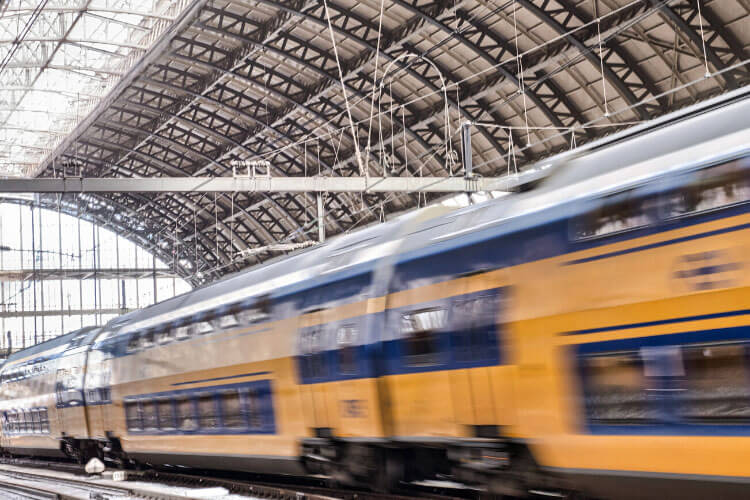
What To Expect When Taking the Paris – Bordeaux Train (And Vice Versa)
As Americans, we’re typically don’t travel by train in the US. The US isn’t that well connected by train even though we do have Amtrack, and travel times can be even up to several days. But train travel in France is generally good, inexpensive and fast. We know it can be a bit daunting using the French railway system. Heck, we regularly even observe other Europeans and French confused about various aspects of using the French rail network, particularly when they don’t use it regularly.
We travel around France and the Nouvelle Aquitaine by train regularly, so using the French train system is practically second nature at this point. We documented a recent Bordeaux – Paris train journey step-by-step from when you arrive at the station through finding your seat on the train to help you understand exactly what to expect.
You should arrive at the train station from 30 – 60 minutes before the departure time of your train. In Gare Bordeaux-Saint-Jean, arriving 30 minutes prior to your train’s departure is plenty. It’s only a couple minutes walk to even the furthest tracks and your train won’t be assigned a track (think of a track like an airport gate) until 20-30 minutes before departure for TGV trains. In Paris, the train stations can be much larger and somewhat confusing. If you’re unfamiliar with the station in Paris, you should arrive from 45 – 60 minutes before departure time.
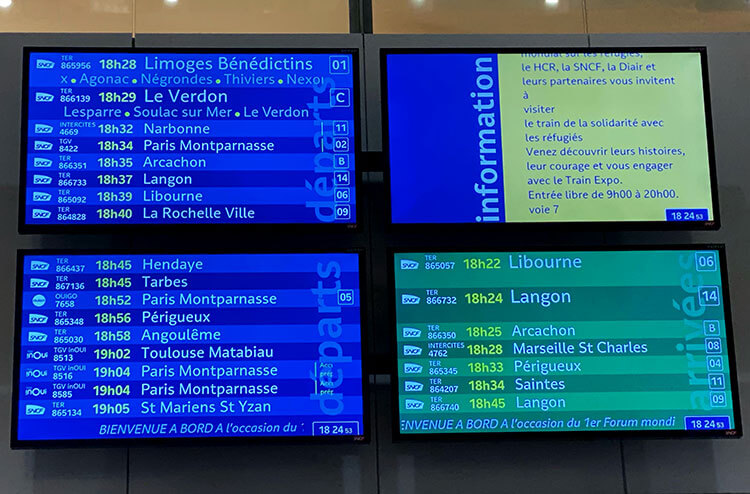
Just like in an airport, there are arrival and departure boards. These boards list the train number, which is like a flight number that you can use to verify you’re looking at the correct train. Next to the train number is the departure time. The final destination of the train is listed after the departure time, for example: Paris Montparnasse. Finally the track number will be listed, typically 30 minutes before departure for TGV trains.
If you’ve purchased your ticket online, you may be able to download and print it. Or if you’ve purchased through an app like Trainline, you may have an e-ticket right in the app. With print-at-home tickets that have a QR barcode and with e-tickets in your app, you can proceed straight to the train track.
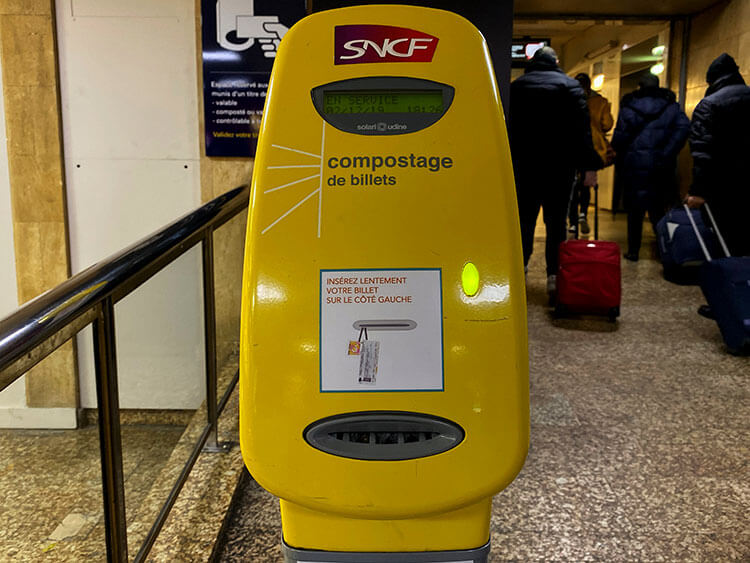
TER trains typically require you to print your ticket from one of the machines in the station. Or if you’ve purchased a ticket from the counter or self-service machines in the station, you need to validate your ticket. You validate your train ticket at a validation machine, which are located around the station. In Bordeaux and Paris Montparnasse stations, the validation machines are bright yellow. Simply insert your ticket and the machine stamps a date and time on it. Without this validation stamp, you can be fined when the controllers come around to check your ticket.
With the Paris to Bordeaux high speed train, a controller checks your ticket before even entering the track. It’s not a security scan like airport security, but just ensures that everyone boarding the train does in fact have a ticket.
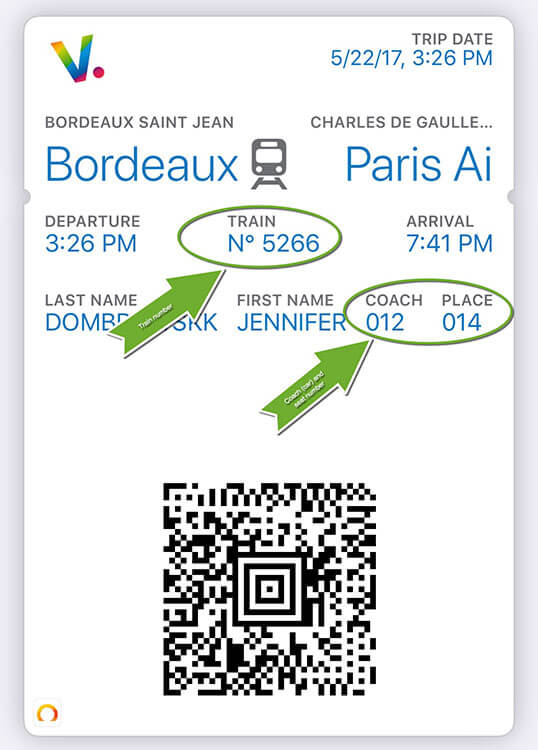
Your ticket has the information about your train coach number and your seat number. It’s generally easier to board the train at your coach (car), otherwise you may need to walk up and down stairs and between cars.
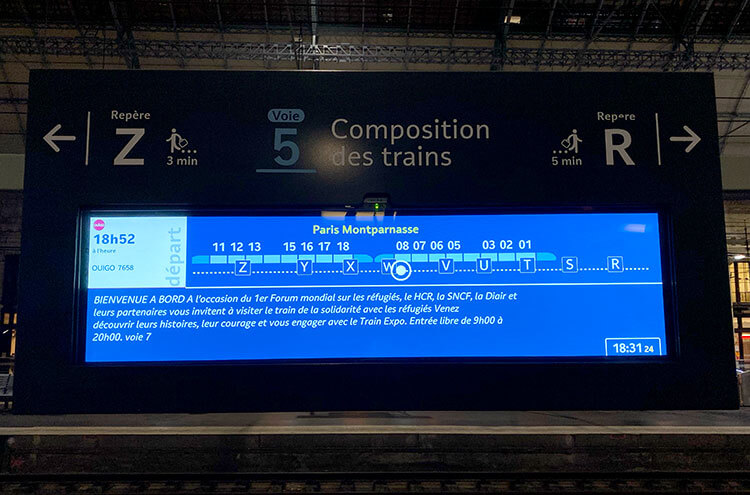
Once on the track platform, you’ll see another digital display showing the layout of the train. While it might seem like it would make sense that coach 1 would be the very first car and then each coach number would follow in numerical order, the train isn’t always laid out like that. The digital display shows where the coaches are, making is easier to know where your assigned coach is located.
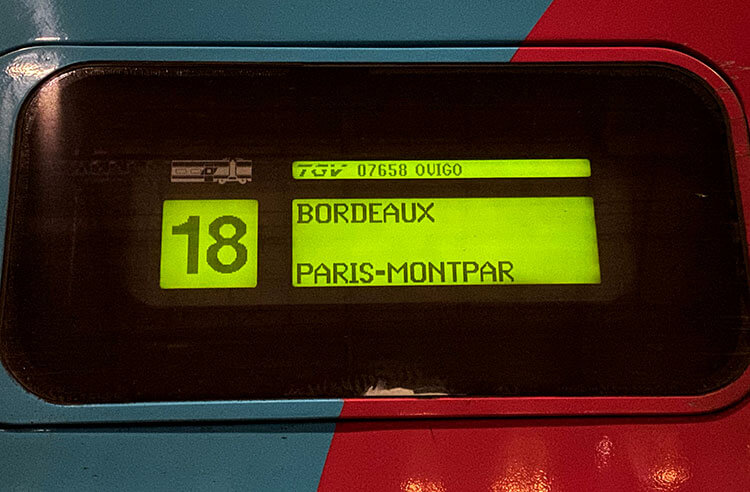
Each coach also has a digital display showing the coach number, the train number, and the departing and final arrival destinations. Verify your coach number before boarding the train.
A little sign in the car either on the wall or on the doors themselves will show which seat numbers are to the left, right or upstairs. Also pay attention for these signs to easily find your seat. Then the seats themselves are again numbered. As in the example above, seat 863 is the aisle seat and 864 is the window seat.
Once you’ve found your seat, you can sit back and relax for the short journey with a Paris to Bordeaux train time of just 2 hours 4 minutes. A controller may come around again to check your ticket, so always have it handy.
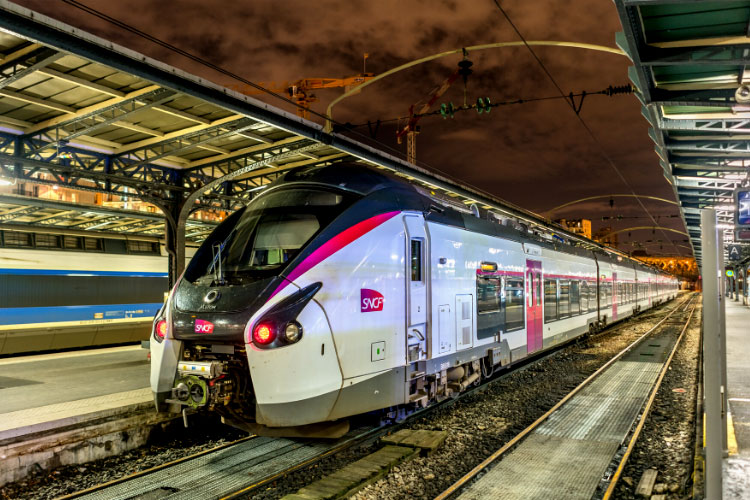
Tips for Train Travel in France
Now that you generally know how to book train tickets and how to use trains in France, there are a few final tips for making train travel in France a breeze.
- Print your print-at-home tickets out or download an app like Trainline to use e-tickets on your smart phone in advance.
- Some tickets like for TER trains are not available to print-at-home or as e-tickets. You’ll need to collect these tickets at the self-service kiosks in any French train station. If you booked on Trainline, you only need the reference number and the lead passenger’s surname to print the tickets from the kiosk.
If you booked on SNCF’s website, you need the original credit card in order to access the booking. The kiosk’s only work with European-format chip and PIN cards, so if you’ve managed to book on SNCF with an American card you’ll likely need to visit the ticket counter to have an agent print your tickets for you. - Don’t forget to validate any tickets you had to print at the kiosks in the yellow validation machines. You simply put the barcode end of the ticket face up, which looks very similar to an airplane ticket, in the gray “mouth” of the machine. It will stamp a time and date code on to the ticket. You may be fined by the controller if you don’t validate your ticket.
- Most TGV trains have a bar car serving snacks, sandwiches, coffee and beer and wine. TER trains do not have a bar car.
You can bring any food and drink on to the train with you, and many people do this. There are usually a selection of cafes and shops selling take-away food items and drinks in the larger train stations. And yes, you can even bring a bottle of wine if you like! - There are no baggage fees, size restrictions or weight limits when traveling by train as there are with airlines – with the exception of OUIGO. But remember that you don’t check bags in and there are no baggage handlers to manage your bags for you. So be sure you can easily lift your bags up the stairs and into the cars on your own.
- Regional TER trains allow you to travel with a bicycle for no charge. There are several Bordeaux châteaux you can reach by regional TER trains, and some we recommend taking a bike with you to easily travel between the train station and wineries.
There’s a small fee for taking bicycle’s on TGV trains and some routes you’re even required to place your bike in a bike bag. So be sure to check restrictions when traveling longer distances with bicycles. - Dogs are beloved in France and they are allowed on all French trains. Smaller dogs that fit in a carrier bag pay just a small fee starting from €7 depending on the train company. Larger dogs must wear a muzzle and be on a leash. After a successful petition in 2021 to make pet train travel more accessible to all, larger pets now pay a small fee starting from €7 depending on the train company. Find all the regulations for traveling with your pet on the SNCF site.
Pet tickets aren’t available to book on Trainline. You have to book pet tickets directly on the various train company websites, at kiosks in the station or in the boutique at the station.
Helpful Words and Phrases to Know When Taking Trains in France
Here’s some helpful terminology to known when using trains in France. But don’t worry: train stations in France, especially in major cities like Paris and Bordeaux, are like international airports. There are usually signs in both French and English.
Gare: train station in French
SNCF: France’s state-owned national railway network, which is short for Société Nationale des Chemins de Fer
TGV: France’s high-speed train network, which is short for Train à Grande Vitesse, and operated by SNCF
OUIGO: France’s low-cost high-speed rail network operated by SNCF
TER: France’s regionally operated rail network servicing villages, and short for Transport Express Régional
Compostez votre billet: validate your ticket, which you do at the yellow machines
Coach: the train car
Place: your seat number
Billet: ticket in French
How to Navigate Train Strikes in France
While the French rail network is very well connected and generally a fantastic way to explore France, protesting is also the national sport. Sometimes trains in France go on strike, and it can be both stressful and a hassle for tourists and locals alike.
Though a major inconvenience, you generally don’t have to worry about if and how a French train strike might affect your trip to France. The most important thing to know about train strikes in France is that they are scheduled in advance, with dates and times posted online in advance. Generally train strikes are announced at least 10 days in advance, and train strikes in France don’t always affect all French trains.
Be Informed of Upcoming Strikes in France
If you’re planning a trip to France, and especially if protests have been making world news recently, you’ll want to bookmark the website C’est la Grève. This website lists most scheduled strikes and protests. The website is in French, but you can pop the site in to your Chrome Browser to translate. You’ll want to be aware of any “grève générale et nationale” as these are national general strikes, and typically some trains such as SNCF and RAPT (regional Paris trains) and public transport is affected. You can also search for transport specific strikes.
The C’est la Grève website is a good start, but you’ll also want to look at the Traffic Info section of your specific train company website. The Traffic Info section will list upcoming disruptions. You can find the most up-to-date Traffic Info for SNCF and TGV trains within France, TGVLyria and Thalys trains to see if your trip is affected.
What To Do If There is a Train Strike in France During Your Trip
So what do you do if there’s a train strike in France and your trains are affected?
Train strikes generally last only one day on the planned strike day. Train strikes in France also do not affect all trains operating in France.
Once a strike is scheduled, SNCF blocks any further booking for the strike day in their reservation system. If your travel plans are flexible, just book your trains for either the days before the strike or the days following the planned strike. Know that trains will more full and busy on the day immediately following a strike.
If you’ve already booked and are mid-travel, a train strike could be much more of a hassle. Generally, SNCF informs customers about the trains or train lines impacted 1-2 days before the strike date by email. Passengers are notified by email and given opportunity to re-book at no additional cost or get a refund if your train is cancelled due to a strike.
If your train is not cancelled, you don’t have to worry. The train will operate (there may be some delays or disruptions), but you won’t just be left stranded last minute.
If your train arrives at your destination late due to a strike you may be entitled to compensation. This even includes your dog, as they also require a ticket to ride all French trains! For TGV, Intercités, OUIGO, and international lines, passengers are entitled to compensations ranging from 25% to 75% of the ticket price depending on the length of the delay with a minimum delay for compensation of 30 minutes.
You can make your requests for compensation for delayed TGV and Intercité trains on this website: https://garantie30minutes.sncf.com/s/?language=en_US
This article contains affiliate links. When you book on Trainline through our affiliate partner sites, we earn a small commission at no additional cost to you.

Mike says
This is super helpful! The only question it leaves unanswered for me is how to get to the TGV from CDG airport when I arrive (in a few weeks).
Jennifer Dombrowski says
Hi Mike,
You can take the train from CDG in to Paris. You’ll need to also use the metro or take a taxi to change train stations.
Pookie says
A question – I’m thinking of taking the TGV from CDG to Bordeaux St. Jean in early November. My flight gets into CDG at 8:00 am. The earliest TGV out of CDG around noon requires one change at Massy Station, with about 50 min to spare, which I assume is plenty of time. Is the Massy Station easy to navigate with a carryon suitcase for someone who doesn’t speak French? Or should I wait around at CDG until 6:00 pm for a direct train to Bordeaux?
Jennifer Dombrowski says
Hi! With 50 minutes, you have plenty of time in the train station. The stations are very simple to use. You likely will need to change platforms when you change trains, but it only takes a few minutes to walk from one platform to another.
Ken says
I am a bit confused about the the most efficient way to get to Bordeau St. Jean from Paris CDG via the TGV. Should I take a local train from CDG to Gare Montparnesse and then pick up the TGV from there? Or can I take it directly from CDG?
Thank you for your help.
Jennifer Dombrowski says
There is a train you can take directly from CDG, but it doesn’t often line up with the flight times the best. I always find it best to just transfer to Montparnasse and then get the direct train to Bordeaux from there as there are trains just about every hour.
Katie Lamb says
How many times does the TGV run from CDG each day directly to Bordeaux. From what I can find it appears to run twice per day… 8:10 am and 6pm. There are many other trains but TGV runs twice. Is that accurate?
Jennifer Dombrowski says
No, it runs many times. There are trains every 1-2 hours.
Jacqui Carter says
Hi Jennifer
My bloke and I are travelling by train to Paris from the Aude on 20th June, changing at Bordeaux, and with only 14 minutes to switch trains. As the timing feels a little tight, I’m wondering whether the Paris train always leaves from the same platform, and if so if you know what number platform it is?
Grateful for any/all help comments!
All the best
Jacqui et Chubb Carter
Jennifer Dombrowski says
Hi Jacqui, the trains depart from all different platforms. The platforms are often only assigned shortly before the train departure. But 14 minutes will really be plenty of time. There is typically a screen in the cars showing connecting train info, so you can know which platform you need to get your next connecting train from. Or you can also look on the website https://www.garesetconnexions.sncf/fr/gare/frboj/bordeaux-saint-jean to see the connecting train info.
Bordeaux is not a massive train station. Likely it will take maximum of 5 minutes to go from the arriving platform to your connecting train’s platform.
Jacqui Carter says
Thanks, Jennifer – this is reassuring and very helpful!
Katie Momo says
This is so helpful!! I’ve been to France (and different places in Europe) several times and only heard about about Trainline from your blog! ALWAYS had trouble getting train tickets, I’m excited to try this. Thank you so much!!
Suzanne Walsh says
Jennifer,
My question is similar to the one above. In September, my partner and I will take the TGV from Paris Montparnasse to Bordeaux. We then have only 11 minutes to find and board our TER train to Perigueux. We are unfamiliar with the Bordeaux station and are afraid that we will miss our local train. I like your suggestion that the arriving TGV will probably show connecting train information. Do you have any further guidance in navigating the station from the TGV arrival area to the TER departure area?
Thanks in advance for your help!
Suzanne
Jennifer Dombrowski says
Hi Suzanne,
TGV and TER trains are all in the same area. As an example, you might be arriving on track 5 and your connecting train departs from track 8. You just get off, walk down the stairs to the underground passageway where all the stairwells to the tracks are and go up the entrance to the track. It only takes a few minutes.
You can look at the arrivals and departures online, or also on the train there will be a video screen with this information. Tracks aren’t assigned until a few minutes (usually 15-20 minutes) before as it’s a constant coming and going of trains.
Ann Spencer says
We are planning to take the TGV from GDG to meet our cruise ship in Bordeaux. How far is the port from the train station? What is the best way to make this connection,,
Jennifer Dombrowski says
Hi Ann,
You can hop right on a tram outside the train station here in Bordeaux. There is a tram stop very near where the ships dock. Tram is definitely the best way!
Heidi says
I normally never leave comments but I have to say this article is extremely helpful and detailed, thank you! I’ve taken trains in S Korea, Czech, Japan, London, Austria, and Hungary and all were fine but for some reason I’m really stressed about the France trains (and my French is pretty good) 😀. I think it’s the Thalys then TGV then TER that got me as they are different stations but your article helped clarify. Merci!
Jennifer Dombrowski says
Hi Heidi! Don’t worry about the different TGV, TER etcétéra. It’s all part of one network. I’m so glad you found the article helpful and I hope you have a great trip!
Laurel Lachesnez-Heude says
Hi Jennifer,
Excellent information but need to ask about Paris-Bordeaux TGV accommodations for a full size piece of luggage.I need to keep it with me. Is this possible?
Many thanks!
Laurel
Jennifer Dombrowski says
Hi Laurel,
Luggage has to go on the rack or fit under your seat on the train. If it’s a large bag that you absolutely have to keep with you in your seat, you could purchase 2 seats. Otherwise, there won’t be guaranteed space for the bag. And it can’t block the aisle. You could also book a seat near the luggage racks so you can keep an eye on your bag.
The good news is that if you have a direct train with no other stops, you can relax once the train starts moving. If you’re worried, you could stand near the luggage rack until the train doors are closed and you’re on your way. Then go stand near the luggage again about 10-15 minutes before your arrival.
Hope that helps!
Frank Corcillo says
looking to go from paris to Bordeaux for a day trip taking the TGV train. Is it mandatory to buy a rail pass or can you just buy a ticket?
Jennifer Dombrowski says
A rail pass is not needed, but you will want to buy a ticket in advance!
Frank Corcillo says
Thanks, for some reason the rail pass is being automatically included in the ticket order. Also, way more expensive than I expected, 350 euro round trip for 2 people!
cari says
Hi Jennifer,
I have a huge hockey bag to carry! We arrive CDG and then need to travel to Bordeaux via train. Will this bag be an issue? Is there a place to pay and store the bag at Montparnasse if we want to leave it and travel the city for the day? Thank you
Jennifer Dombrowski says
Hi Cari,
Yes, you can bring the bag on the train. There is a luggage area to place bags. Sometimes, like on OUIGO, there is an additional fee for large pieces of luggage like you are describing. But it is a nominal fee – on OUIGO there is an option called OUIGO Plus. It is 7€ to add OUIGO Plus on to your reservation and it includes a piece of hand luggage, a carry-on piece that you can place either under your seat or on the rack above the seat and a large piece of luggage you can place on the rack.
And yes, there are luggage storage options right in the Montparnasse station if you want to store any bags for the day while exploring before your train.
Julie A says
Thank you for this information. one question I have is when traveling Ouigo. What do you do if you have a full size suit case from your travels?
Jennifer Dombrowski says
With OUIGO, you have an option called OUIGO Plus. It is 7€ to add OUIGO Plus on to your reservation and it includes a piece of hand luggage, a carry-on piece that you can place either under your seat or on the rack above the seat and a large piece of luggage you can place on the rack. You also get a choice of seat included and access to the Fast Pass line when traveling from Paris. I use this option myself when I have a few bags. Hope that helps!
Sarah says
Hi! This post is so helpful! My family is going to France this summer and going to visit friends in Amsterdam. We used Trainline per your advise and found a route. It does say 2.5 hours “to change stations” between Paris Montparnasse and Paris Gare du Nord. So the train does not take us to Paris Gare du Nord? We have to find our own way? Another train?
Thank you!
Sarah
Sharon says
Your information is very helpful! I am still uncertain EXACTLY how to land in Paris and get to the train station to get to Bordeaux. Thank you!
Vee says
I bought a ouigo ticket online on the SNCF website going from Montparnasse to Bordeaux. (No problem with the US credit card by the way). I did not realize that I had to pay extra for more than one piece of luggage. I have a full-size suitcase and a box. Is it possible to surplus the surplus charge at the train station?
Jennifer Dombrowski says
You can just add extra luggage in your booking.
vee says
I didn’t bother and was able to bring both pieces of luggage anyway. No one was checking. There was plenty of space. Incidentally, I payed extra to change my seat after booking to be close to my friend which I didn’t need to do either. There were extra seats and I could have easily swapped seats.
amy lebowitz says
This is super helpful. We are flying in to Paris at the end of August and need to take a train to Bordeaux. We just realized that the trains from the airport don’t run very often and ofter very few direct trains. How far is the Montparnasse train station from the airport? Is it easy to get a taxi from the airport to Montparnasse to catch the TGV direct to Bordeaux? Thanks!
Jennifer Dombrowski says
Hi Amy,
Yes, it is very easy to get a taxi from the airport. Paris taxis have a fixed rate of 55€ to travel to the Right Bank of Paris, and 60€ to travel into the Left Bank. Montparnasse is on the Left Bank.
John Civic says
So, I have read the above questions and I still do not see an answer as to how one gets from CDG airport to the train station.
Also how does one know what to book on Trainline Aéroport Paris Roissy Charles de Gaulle CDG T2 or Aéroport Paris Roissy Charles de Gaulle CDG?
Jennifer Dombrowski says
Which train station are you asking about getting to? There is a train station in CDG airport. If you’re traveling from another of Paris’ many trains stations, then there are a variety of transport modes to get from CDG to that particular station that could include taxi, metro, RER, bus or a combination of several modes.
Elizabeth Preuss says
This is such good information and I think we might use the train to go from Paris to Bordeaux. The questions I have are regarding seats and storage. I did not read or see any pictures on the seats and where we will store our luggage.
Are the seats individual like an airplane? Do we all face the same direction? Or are we facing other people? Will our knees be touching?
Or are they a bench seat like a bus? Will our luggage sit in the floor between our legs or in upper compartments and is that a problem with the amount of availability?
Thanks in advance.
Jennifer Dombrowski says
There are luggage racks in each train compartment. This is where larger pieces of luggage go. There is a small rack running above all the seats on each side of the train, and you can place things like a jacket or a small backpack or tote back above.
As for seats, there are seats facing both directions. In standard class, it is typically two seats on either side of the aisle. There is usually two tables with four seats around the table in each train car, and these are the only seats where you would be facing other passengers.
Carol says
Very useful info, thank you. We are planning to take a TGV from Paris to Bordeaux on Friday 7th June to link up with a river cruise starting Sunday 9th June. If there is a strike on the Friday, how likely is it that there will be sufficient seats available on the Saturday for us to change to, or failing that, the Sunday?
Jennifer Dombrowski says
You would know at a minimum several days in advance if your particular train is going to be affected. Even on a strike day, not all trains are impacted. Some still run. So it’s not something to exert a lot of worry over. In the worst case scenario, there are other modes of transportation from buses like Flixbus or a car rental.
Carlin says
Hi,
This information is so helpful! Family friends and I will be traveling from Paris to Bordeaux in May and then renting a couple of cars to head to the Dordogne for a week. Do you have a recommendation on booking a rental car near Bordeaux St Jean or at the Bordeaux airport? Also, when selecting seats on the train is there a way to tell if you are facing forward or backward? Thank you!
Jennifer Dombrowski says
Hi! It depends on which train you’ve booked. With OUIGO for example, there’s no way to know the direction of travel when reserving seats. For rental cars, I’ve rented cars both from the train station and airport. Either are very easy to access by tram, and I usually find the prices a bit cheaper from the airport. I always recommend sticking with the major worldwide companies like Budget or Sixt.
Liz Pierce says
My husband and I will be traveling from Paris to Bourdeaux this September along with two family members. We’re all on the “mature” side, and the thought of carrying our bags onto and off the TGV is daunting. I know you said there are no porters–is there any way to get baggage help there and, later, at Bourdeaux for the trip back to Paris?? We’re willing to pay, of course. Thanks!
Jennifer Dombrowski says
There is luggage porter service at all major train stations, however, this service is only available for disabled passengers holding a disability identification card. Otherwise, you need to be able to handle getting all your luggage on and off the train. If you have large luggage and this is of concern, you might consider a luggage shipping service to send your luggage from Paris to Bordeaux so you don’t have to manage it.
Elaine Hammer says
This website is incredibly helpful! I am traveling to Bordeaux the end of June and we are flying into Orly; what would you recommend as the best way to get to the Montparnsse Station; metro or taxi?
Jennifer Dombrowski says
Hi! The metro stations have a lot of stairs, which can be a real hassle when you’re carrying luggage. Escalators and elevators are not available in every station. Honestly, a taxi or Uber is worth it when dealing with luggage.
Ana Aceti says
Hoping you can help as all the above information is a bit overwhelming. On Sept 18 we need to travel from Bordeaux to Munich. It seems that the best option is to take the train to Paris then fly Lufthansa from Paris to Munich.
I’m trying to figure out the train and metro schedules to determine if we can make a 2:30p flight out of CDG to Munich. Can you please help me?
Jennifer Dombrowski says
To go the distance from Bordeaux to Munich, it is best to fly. You can fly from Bordeaux to Munich. Even with the connection, which is usually in Amsterdam via KLM, it will be far less expensive, faster and remove all the stress of getting to Paris to transfer to the airport for a flight.
Jan Singer says
Great information on this site. Much appreciated.
I will be traveling by train from Paris Montparnasse to Bordeaux and then changing trains with Angouleme as my final destination next month. Although I have a coach and seat number on the Paris to Bordeaux train, all I have is a train number and barcode for the Bordeaux to Angouleme ride.
My ticket was booked through RailEurope. Does no coach and seat number mean that I can take any coach and seat on the ride to Angouleme?
I look forward to your reply. Thank you in advance.
Jennifer Dombrowski says
The OUIGO train between Bordeaux and Paris often already makes a stop already in Angouleme. I’m a bit confused. Are you staying in Bordeaux to visit and then going to Angouleme? Otherwise, Angouleme is in between Paris and Bordeaux, so there would be no reason to go all the way to Bordeaux to then go back north to Angouleme.
Jan says
Hi Jennifer. My final destination is Angouleme. Apparently there is no direct train from Paris to Angouleme on the day of my travel (5/18/24). So I have to go to Bordeaux and then change trains and go from Bordeaux to Angouleme. I have about 10 minutes to make that transfer. And there is no coach or seat number on my ticket. Can you offer any advice on a change of trains in Bordeaux? And because I do not have a seat number, can I assume that I can sit anywhere? Thanks again.
Jennifer Dombrowski says
There are a lot of French holidays in May and that is a Saturday, so the direct trains are likely already sold out. I had a look and presumably you have one of the trains booked that changes in Bordeaux. You change to a TER train, which is a regional train. These don’t have assigned seats. So when you change, you just get on and find an empty seat. And don’t worry about the amount of time to change – 10 minutes is plenty of time! I’ve even taken my dog out to potty quickly with 10 minutes time. Gare Bordeaux Saint Jean is actually quite a compact train station.
What I advise is about 10 minutes before you are due to arrive in Bordeaux, gather your things and go to the door of the car to be ready to hop right off. You can just stand in the entrance area of the car, and you won’t be alone doing it. You can also look on the app or the website for Gare Bordeaux Saint Jean https://www.garesetconnexions.sncf/fr/gares-services/bordeaux-saint-jean/horaires ahead of your arrival to see which track your connecting train is on by clicking the Horaires tab. It will show you arriving and departing trains like an airport arrivals and departures board. There are also screens all over the station – on the tracks and in the hall connecting the tracks – which you can look at to see which track your train is on.
Hope that all helps!
Jan says
That is such a great help Jennifer. Thank you so much!!
Wendy says
Hi, to take the train from CDG to Bordeaux, which train station should we use at CDG? There appears to be 2. If our flights don’t line up, is there a train from CDG to Montparnasse? I saw a reference to a taxi. Thanks
Jennifer Dombrowski says
There are 2 stops at CDG, one for Terminal 1 and one for Terminal 3. The same train lines run from both stops, so it only matters which Terminal you will be in. There is not a train from CDG to Montparnasse. You can take the RER and metro to reach Montparnasse or a taxi.
Michelle says
This is such a great website, thank you! I have a timing question about getting from CDG to Montparnasse. Traveling with family including our mother who is in her early 80s so needs to be leisurely paced. We arrive CDG around 12:35 on a Friday (August) and there is a train leaving Montparnasse at 15:11 but worried that will be a little tight since we are unfamiliar with everything, or possible flight delays. Thinking we would taxi/uber to Montparnasse. There are not many tickets left so hoping to book soon. Otherwise there are later options around 16:06 on a longer train, and 17:00 again a short one but then we have a long delay. Suggestions? Also, is it much cheaper to buy round trip since we are still figuring out our return plans, wondering if we could just get teh outbound now or if it will cost a lot more. Thank you!
Jennifer Dombrowski says
Hi Michelle,
In a best case scenario of your flight arriving on time, planning around 1 hour for passport control and collecting your baggage, plus the travel time by taxi to Montparnasse, you’ll arrive within 2 hours of landing at CDG. So I feel like a train at 15:11 is very much cutting it close and there is a real possibility you would miss the train. I would opt for the 17:00 train to give you some cushion of time, and I honestly think you will be waiting to board for a much shorter amount of time than you think. There are plenty of restaurants, cafes and shops in Montparnasse. The station is almost like a shopping mall.
Also, train tickets are sold by one way. Buying round trip doesn’t make the fares any cheaper. But as August and September are pretty much the peak travel times – and even more so this year with the Olympics and Paralympics during that period – I would suggest purchasing your train tickets as soon as possible once you figure out your return plans.
MSR says
Hello! Great blog – thank you. Forgive the slight deviation, but would you be able to advise if an hour and 5 minutes would be sufficient to get from Gare du Nord to Montparnasse? We’ll be coming from the UK and hoping to get the SCNF from Montparnasse to Bordeaux – although I can’t see many options on Trainline/Eurostar with a longer transfer time.
Many thanks!
Sakib
Jennifer Dombrowski says
Yes, you should be fine! From Gare du Nord, you can take the M4 line to Montparnasse. It should only take 20 minutes as it’s a direct metro line between the stations. Just don’t waste any time in between. I’d also book the flex ticket that allows you to make changes in case of any delays on your Eurostar train.
msr says
Amazing, thank you!
Christoper Wright says
Hi Jennifer, and thank you so much for the excellent information!
I will be flying to Paris in May 2025 and, after a few days stay, taking a train from Paris to Bordeaux. I’ll be bringing along a bicycle, which will be packed in a large cardboard box. What options exist to get 2 travelers with luggage and 2 large bicycle boxes from Paris to Bordeaux?
Thank you in advance for any help you can provide!
Jennifer Dombrowski says
Hi, you can take a bagged and dismantled/foldable bike on this route. There’s an option to add the bike when you make your ticket reservation and currently the fee is €5. My husband has taken his boxed up bicycle on the train when he flew from the US. What he did was cut a “handle” in the box and attached a small flat dolly cart with some tape. Don’t check the bicycle box in with the dolly attached. Put the dolly and tape in your carry on, and attach it after you pick up the bicycle box from baggage claim. He also highly recommends attaching an Apple Air Tag to your bicycle inside the bike box so you can track it if the airline loses your luggage. Hope that helps!
Tristan says
Thanks for this detailed summary, Jennifer. We’ll be in Dordogne for 10 days in June then taking TGV from Bordeaux to Paris for 4 days. We bought the tickets weeks ago through Rail Europe and have a QR code PDF ticket for each person. Do we just show/scan that code somewhere to access the train in Bordeaux? Or is there some process where we need to get a physical ticket at the station?
Also, any suggestions on wine tour/tasting in the Dordogne region? We’re staying in Le Bugue but will have a rental car so an hour or so drive isn’t a big deal.
Thanks!
Jennifer Dombrowski says
Your QR code is your ticket. In Bordeaux, sometimes you have controllers scanning tickets as you enter the platform and you cannot pass the gate to the platform without them scanning your ticket. Other times the controllers come through the train and scan your ticket sometime during the journey. It just depends.
As for Dordogne wine, you have the majority of wineries around Bergerac and will be around 1 hour or less from where you are staying. Here are some places you can visit: https://bordeauxtravelguide.com/discover-bergerac-wines/
Enjoy your trip!
Maria W says
Thanks for all your great info about the trains between Paris and Bordeaux. Are you aware if a US passport or drivers license is sufficient to show someone qualifies for the “senior” train ticket rate? I’ve seen references to needing to have a special identification for this. Thank you!
Jennifer Dombrowski says
To get a senior discount advantage, you have to purchase a card called Carte Advantage Senior for the price of €49. The advantage card is good for 1 year and gives card holders 30% off all bookings. You would have to assess how much you will actually use the train for your trip and if the 30% savings is more than the €49 cost of the card. You can order the card online and receive it digitally here: https://www.sncf-connect.com/catalogue/description/carte-avantage-senior?